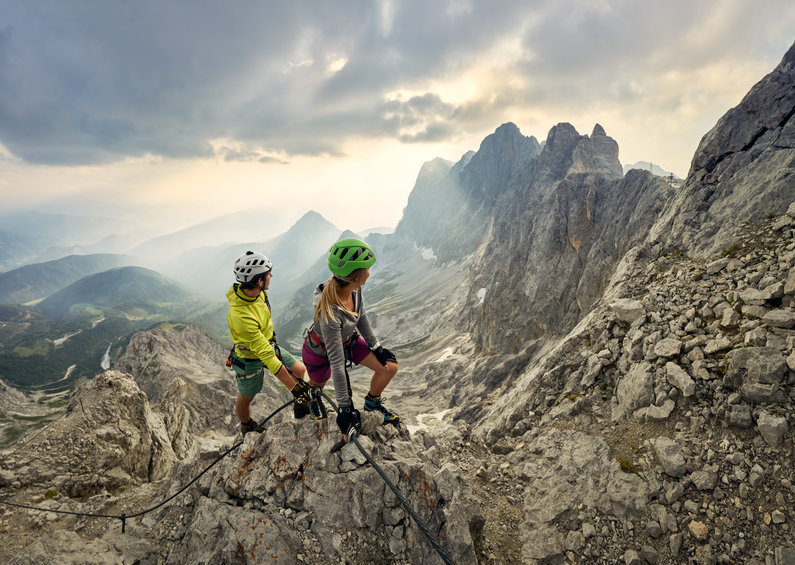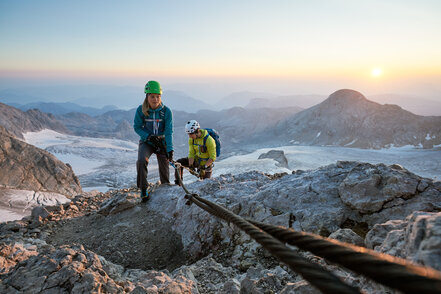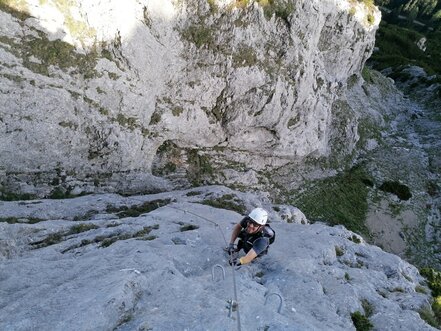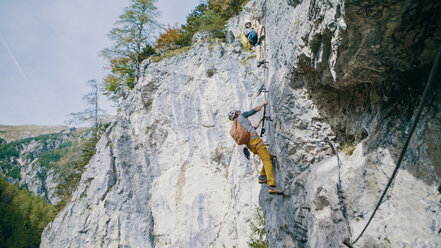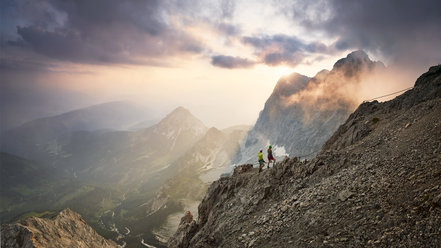For your safety
Via ferrata is a demanding sport in the midst of beautiful, rugged nature! Please follow a few rules for your safety. 1:
1. via ferrata tours are strenuous and require stamina, a head for heights and surefootedness.
2. always use a via ferrata set and a helmet and attach them to the safety rope. Many mountain rescue missions are due to carelessness and bad weather. 3.
3. many tours are all-day. Always take the possibility of a change in the weather into account when planning the day. Be especially careful with clothing and provisions.
4. always behave considerately. Respect other climbers and inform them of dangers. 5.
5. treat nature with care!
Alpin-Emergency call
Mountain rescue 140
Europe Emergency Call 112
Via Ferrata Difficulty Ratings (Schall-Scale)
Ratings of via ferratas are based on subjective criteria and are therefore only intended as guidelines. The attempt has been made to reconcile the subjective assessment of difficulty with a concrete rating system. Up to now, there has been no uniform international or European rating scale for via ferratas. Proven systems that are widely used in the German-speaking world are those developed by Kurt Schall in the mid-1980s, aptly named the “Schall Scale” (ranging from A to F, incl. intermediate levels), and the “German Via Ferrata Scale” (K1 to K6 as defined by Eugen Hüsler, or KS1 to KS6 according to Paul Werner).
The following definitions were taken from the current “Klettersteig-Atlas Österreich” (www.schall-verlag.at):
A = Easy (blue)
Simple, secured climbs. Flatter (longer) or vertical (short) ladders, railings and iron rungs, mostly in not very steep terrain. Isolated points may be rather exposed, though are easily negotiated (e.g. rock ledges, small footbridges). The terrain can also be hiked without resorting to safety features (exception: ladders up small rockfaces), with good foot- and handholds. In general, via ferrata equipment is not required for hikers who are surefooted with a good head for heights. Generally suitable for children/youths and beginners, though even in this case, a set of via ferrata gear is recommended!
B = Moderately difficult (blue-red)
Somewhat steeper rocky terrain with exposed passages and restricted footing. Longer vertical ladders, iron rungs, pegs or chains. Many passages may be strenuous and strength-sapping. Even more experienced mountaineers will need to use basic via ferrata equipment. For beginners and children, a via ferrata set is a must, whilst a short safety line is also recommended on longer climbs.
C = Difficult (red)
Steep to very steep rocky terrain. Passages with little space for footing and almost always exposed. Vertical and slightly overhanging ladders, iron rungs and pegs, in some cases far apart (potentially problematic for shorter people and children). Often vertical sections only secured by a steel cable, single- or double-cable bridges, suspension bridges. Occasionally very strength-sapping longer ascents within this degree of difficulty are already major via ferrata challenges. Inexperienced climbers and children/youths should be roped on by an experienced via ferrata partner. Full via ferrata equipment is a must.
D = Very difficult (red-black)
Vertical, often overhanging rockfaces. Iron rungs and pegs are often far apart. Generally very exposed, steep rock, often only secured by means of a steel cable. Places high demands on climbing technique (restricted footing, smooth rock) and mind (“tests of courage”). Longer, vertical or overhanging passages demanding a significant degree of arm strength as well as general physical conditioning. Climbing experience an advantage (climbing technique, finding natural hand- and footholds, economic motion etc.). Even for very experienced via ferrata climbers, a complete set of via ferrata equipment is now obligatory (potentially also climbing shoes with no-tread sole). No longer appropriate for beginners, children or inexperienced climbers.
E = extremely difficult (black)
Mostly overhanging rocky terrain. Extremely challenging with respect to arm strength (endurance and maximum strength), climbing technique, skill, courage and mindset! Only for true “professional” via ferrata fans. For longer climbs in this category, optimal physical condition is a must! In addition to the standard via ferrata set, also a short sling (ca. 40 cm) with carabiner (to take some strain of the arms, rest in place and attach to safety features) is highly recommended. Otherwise, virtually identical to the characteristics as described under “D”.


